Independiente del Valle has become one of the biggest teams in South America in terms of their incredible youth academy that is based on education, psychological balance and technical-tactical qualities of players who join them.
Academy graduates at Independiente, such as Brighton standout Moisés Caicedo, Belgian Pro League recent signings Angelo Preciado, Anthony Valencia, William Pacho, others like Alan Franco, Patrickson Delgado, Jackson Porozo, Gonzalo Plata, José Hurtado or Bundesliga‘s star Piero Hincapié are some examples of what Independiente are doing year by year.
Players can be sure that they are in the right place, which is going to give them the perfect tools to make their dream come true.
Exactly 26 days ago, Independiente del Valle lift once again the CONMEBOL Sudamericana Cup, just like they did in 2019, with the likes of Alan Franco inside the starting eleven being one of the key players at only 21 years of age.
In that time, they won 3-1 against Argentinian Colón, this season, it was against Rogério Ceni’s Sao Paulo, with young players like 20-year-old Marco Angulo, 24-year-old Lautaro Díaz or Luis Segovia, and the main man of this piece: The 20-year-old Jhoanner Chávez.
This is just the tip of the iceberg, Independiente have come from a 2016 CONMEBOL Libertadores Cup were they where runners-up, won the u-20 Libertadores Cup in 2020 and were runners-up in 2018 and 2022.
They won their first league title in 2021 and have acquired European managers like Renato Paiva or Miguel Ángel Ramírez, who brought beautiful playing methods and philosophies not only to Independiente, but to Ecuador as a country that has become a league where teams often try to be in possession of the ball, directly affecting the National Team too, where lots of players are academy graduates from Independiente and can play brilliantly in possession-based ideas.
Jhoanner Chávez has not made his first appearance for his native Ecuador, but just yet, as he’s probably the most interesting and promising player at the left-back spot, and surely one of the most intelligent players on the pitch.
Being one of the biggest young talents in his country, we have decided to scout him and analyse why he’s one to watch for the future.
This Jhoanner Chávez tactical analysis piece will be a scout report of Chávez.
It will be an analysis of the left-back’s strengths and weaknesses, as well as looking at where he has fit into Independiente’s tactics thus far.
Jhoanner Chávez Positioning
Independiente del Valle often play with a back three where Jhoanner Chávez likes to sit wide in the first stage of the build-up.
He has plenty of freedom on the pitch, and license to go very forward and join the attack.
However, his head coach, Argentinian Martín Anselmi has given him a fantastic role to play inverted in the build-up, leaving his zone and freeing space there for a teammate that could receive, and then pass it to Chávez who has big off-the-ball movements.
His heatmap from the present season shows his amazing attacking display and use of many channels in every build-up and also the way he plays inverted in the build-up.
Jhoanner Chávez Heat Map
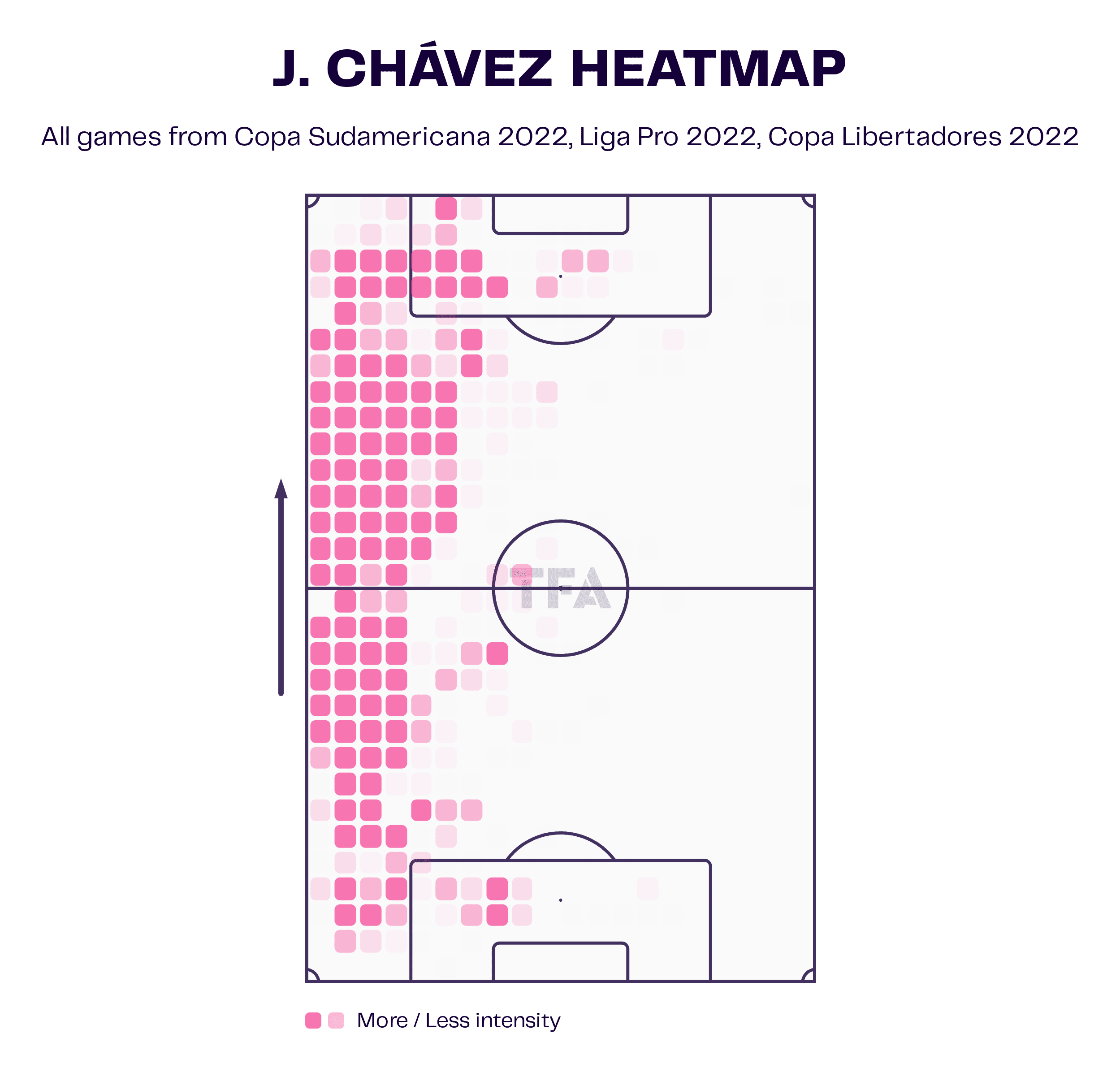
At his age, he has a great ability to understand when he has to make the exchange of channels between the wide and half spaces, with great chemistry with his midfielder or centre-forwards when he’s high on the pitch to set the movements.
Against Macará in the Ecuadorian Serie A, we can see that his pass map is a big example of what he can offer when playing between the lines in the middle, but also staying wide where he delivered two cut-back crosses inside the penalty box.
This tactical ability to move across different areas is not often seen in young talents across the world.
Jhoanner Chávez Pass Map
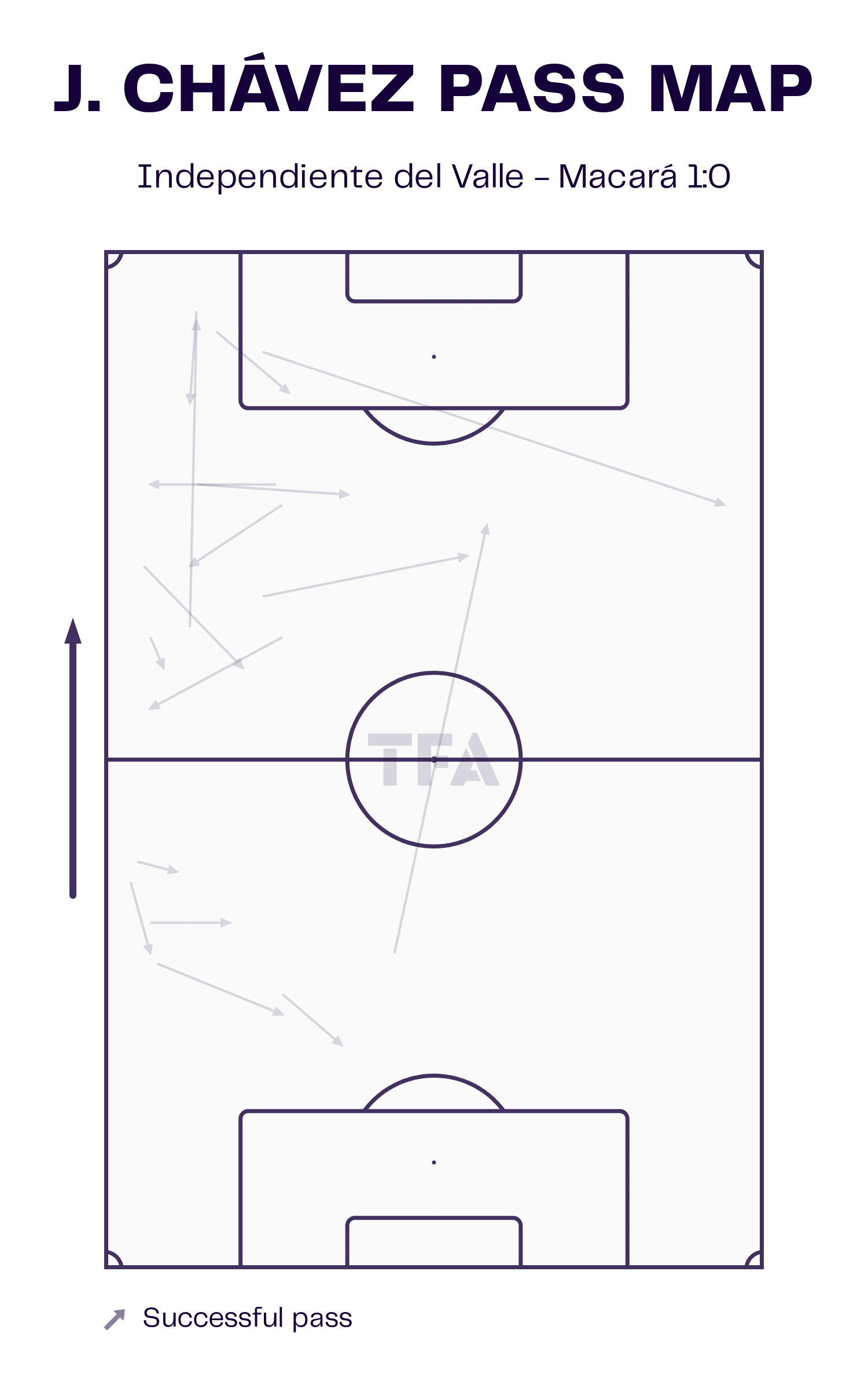
Jhoanner Chávez likes to place inverted to drag and confuse defenders to decide whether to jump or not off their line.
This can generate spaces at the opposition’s back, where he can start to show his powerful stride and sprint that normally makes Independiente del Valle progress and create a threat over the left wing.
In this occasion against Macará, Chávez came to the middle to be a passing option there and free the wing for a teammate.
However in this sequence, what is going to happen is that with his positioning, he drags a marker, leaving a dangerous space between the centre-backs to attack if the ball is played nicely.
This movement allows his team to play the ball wide, but at the exact moment this happens, Jhoanner makes the run forward and leaves space for his teammate in midfield, that is going to be an option there and after he receives, he delivers a long-ball within his first-touch to Chávez that is making the run.
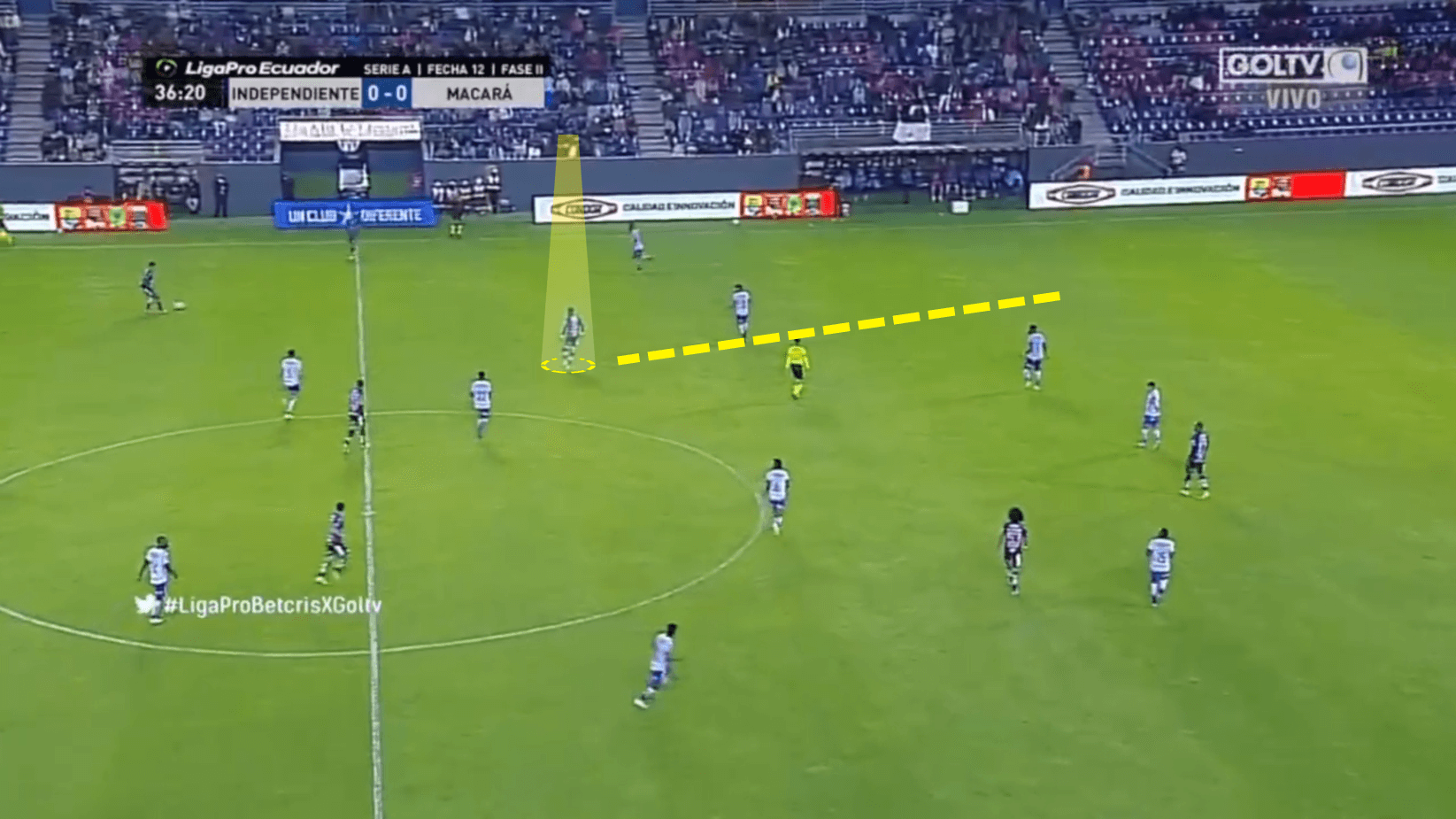
Nevertheless, Chávez also can play as a natural left-back that usually hugs the line.
In this kind of position, the 20-year-old has excellent distribution capacities, especially playing short and direct, almost every time with his first touch of the ball, as Independiente like to build from the back and beat the press in four or five passes.
It’s almost obvious that his associative skills are very good, because normally the full-back that goes inverted, has the skills to play with his back to goal and give few touches to the ball.
Two situations are normally seen when Chávez tends to play wide, one in his own third and in the final third.
In the first steps of Independiente’s possessions, we can see a simple but effective automatism that moves the strong-side midfielder closer to the wing-back, who’s receiving wide, in this case, our main man Chávez.
He plays it immediately after receiving from his midfielder and makes the supporting run to create a new and more high passing option.
These situations can be progressive in two ways: the midfielder has the quality to make a through-pass on the half-turn or create a third-man stage where the midfielder passes it back to the centre-back who then plays a long ball.
In the picture below, it was a third-man movement.
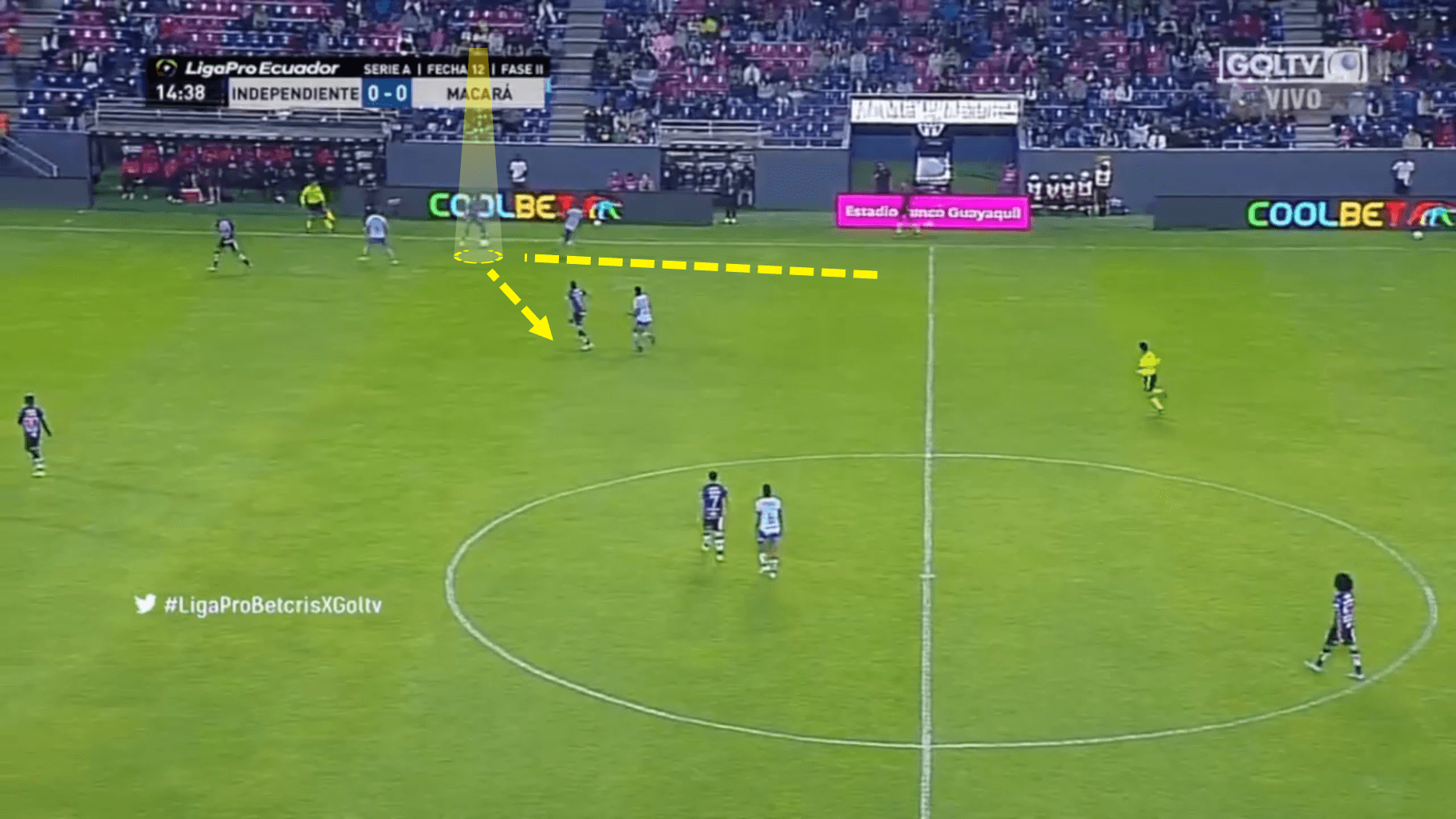
Martín Anselmi likes his team to mute from an ecstatic back-three in possession to a “back-four” where Chávez pins like a left-winger.
Normally this is made as Independiente overload many players in the central areas to then release a long pass to the outside player.
This can be seen many times in the Ecuadorian system as the 20-year-old left-back has a strong build to hold the ball in physical 1v1 duels, and the dribbling quality to elude rivals and get into the box.
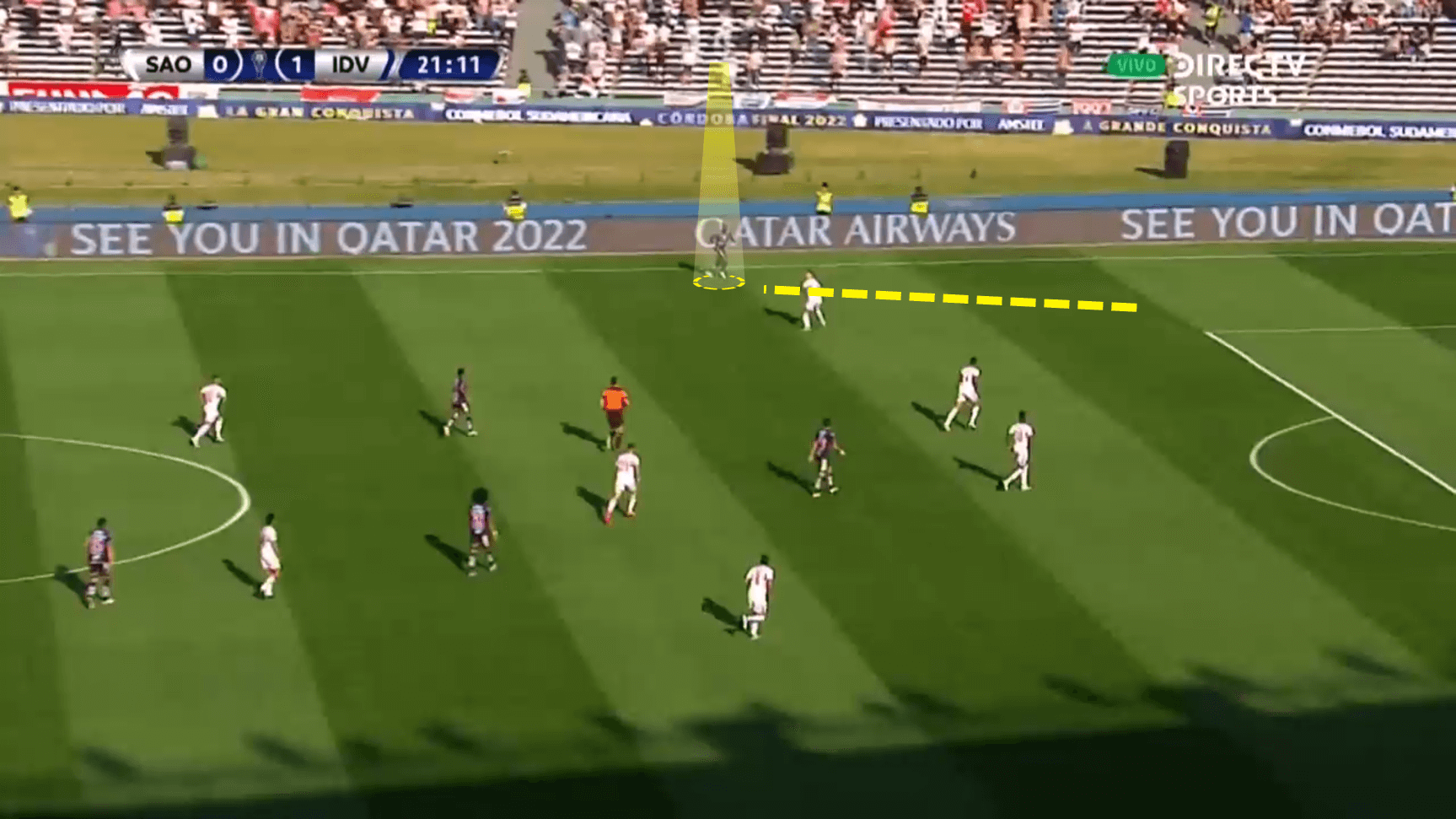
Jhoanner Chávez Attacking Output
Jhoanner Chávez’s biggest contribution to his team is in the attacking phase.
He has a long variety of tools to escape from small spaces, as well a great crossing ability and the right aggressivity to penetrate the box and score goals with a preference for powerful shots, that also are a threat from outside the box when he stays behind in a more inverted role.
His off-the-ball movements are one of the greatest features of his games.
As mentioned before, he possesses tactical intelligence to step into different zones of the pitch in the first passes of the build-up.
Also, in the middle and final third of the pitch, Jhoanner shows great movements to be active from the outside to the inside and vice versa.
These exchanges are normally made in the middle third to final third, and give a lot in terms of having a free-man in creative positions, as he confuses rivals to decide which player they’re going to mark, thanks to the rotations.
In the figure below, Independiente are attacking from the left-hand side of the pitch, a regular sight in their game thanks to the strong threat that comes from there.
Marked in yellow, Chávez has changed from the wide channel to the half-space, making a run inside the box behind the full-back to then execute a cut-back cross to the penalty spot.
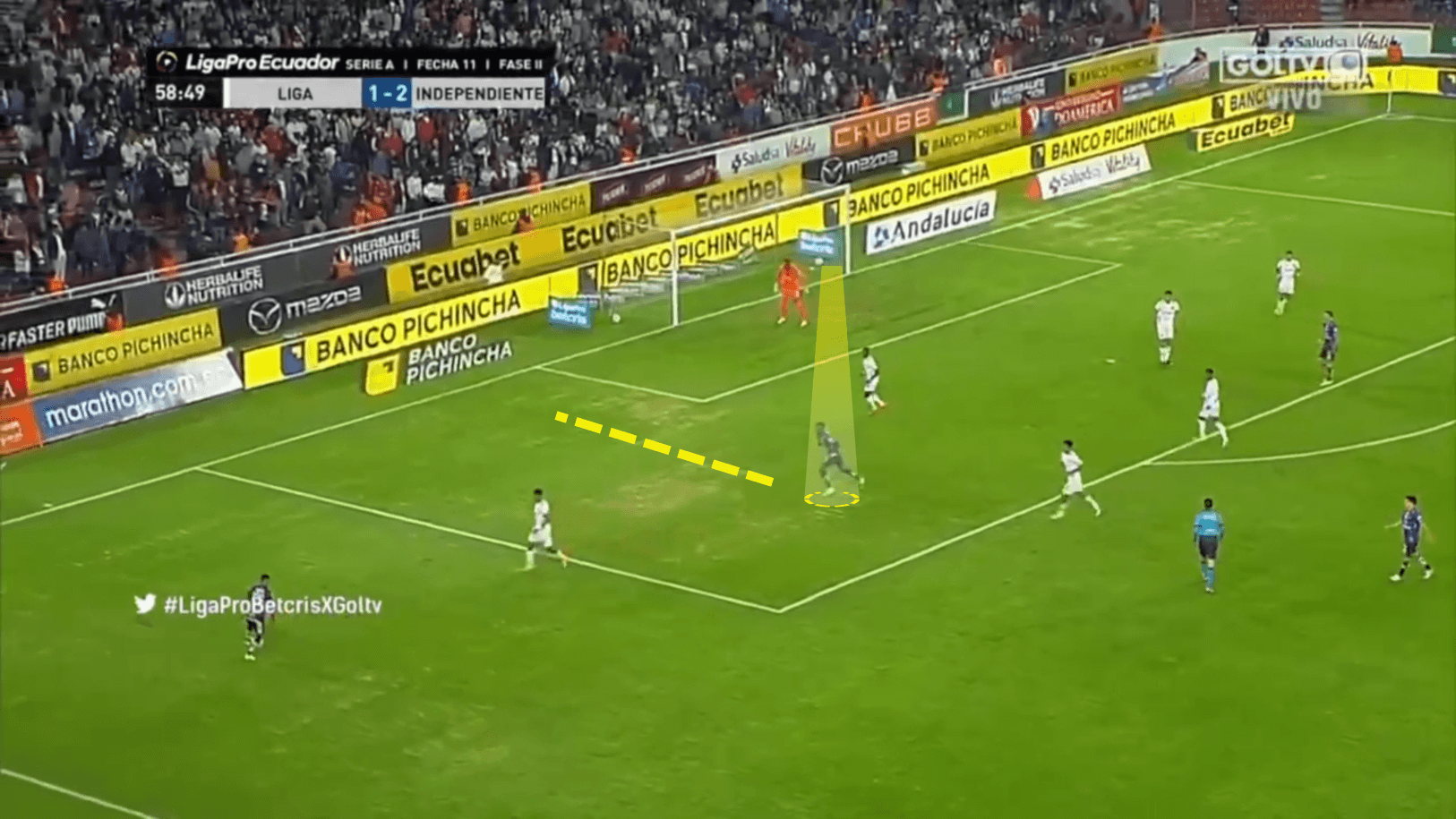
We can see these types of runs in the middle third as well, where he’s often leaving his zone to elaborate combinations and one-two situations through the middle to then be activated like the picture below can show.
A teammate receives the ball very wide, while Jhoanner Chávez is already making a rapid movement to the outside, where he’s going to grab the ball and carry it aggressively, as this is one of his trademarks in his game.
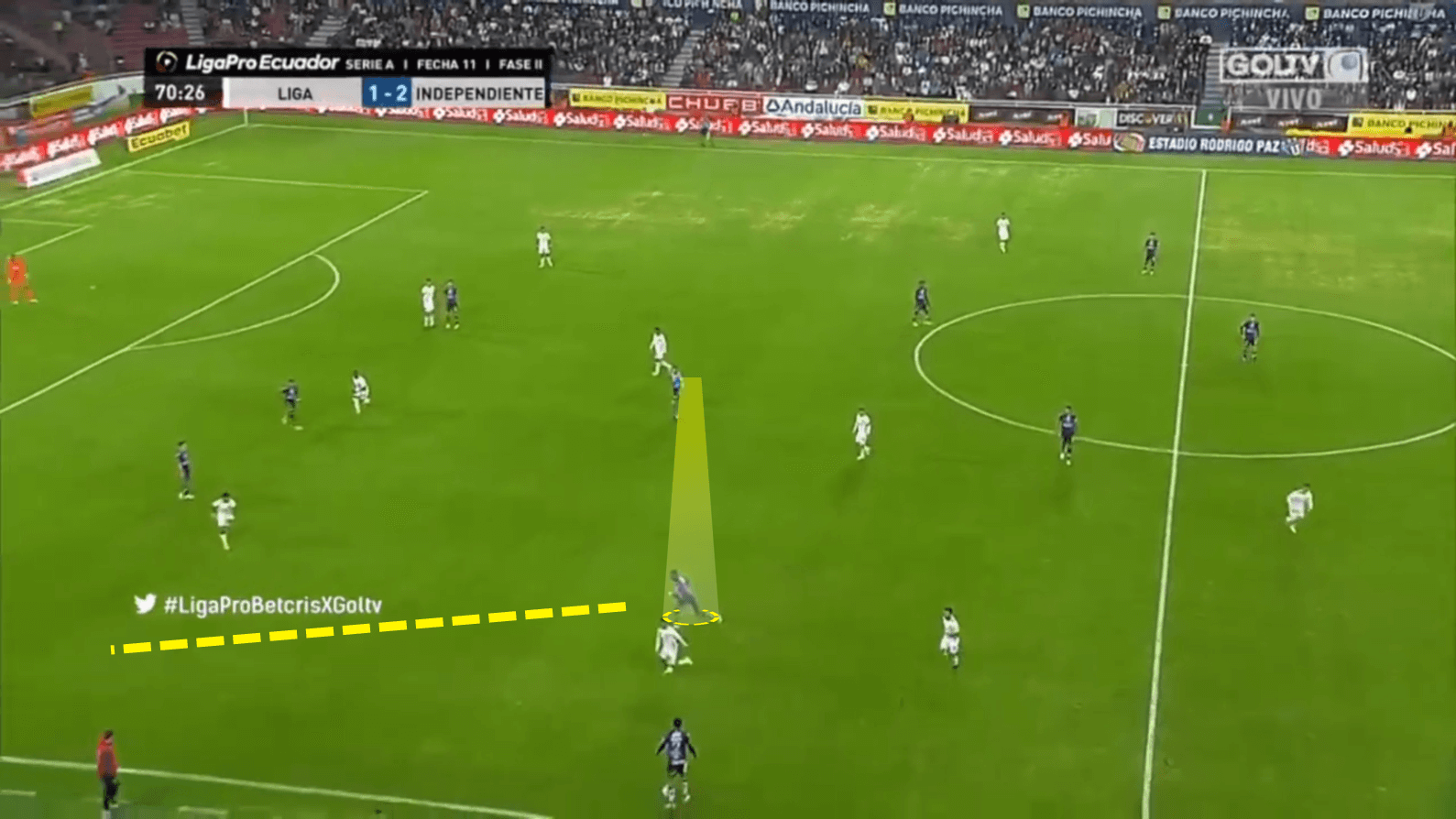
These carries are very important to point out in this piece as they’re probably the most common and successful ability Chávez shows on the field.
His overwhelming athletic build allows him to beat players thanks to his pace and strong lower body that can leave opponents behind, combining greatly physical attributes and technical qualities.
He likes to do it in every third of the pitch, and he’s not afraid to lose the ball in one of these progressive runs with the ball, as he’s very confident and mentally sharp.
When he sees the opportunity to receive the ball, take on a player and run at top speed, he’s going to do it.
He has a very nice end-product and technical deliveries when running.
Data viz below can explain what we are talking about: He massively relies on his ball-carrying ability, and he does it from everywhere: in the final third, to then shoot closer to goal or generate shot assists, In the middle third to elevate his team higher, in his own third to beat the press in an individual decision that helps collectively his team as well when they ran out of ideas.
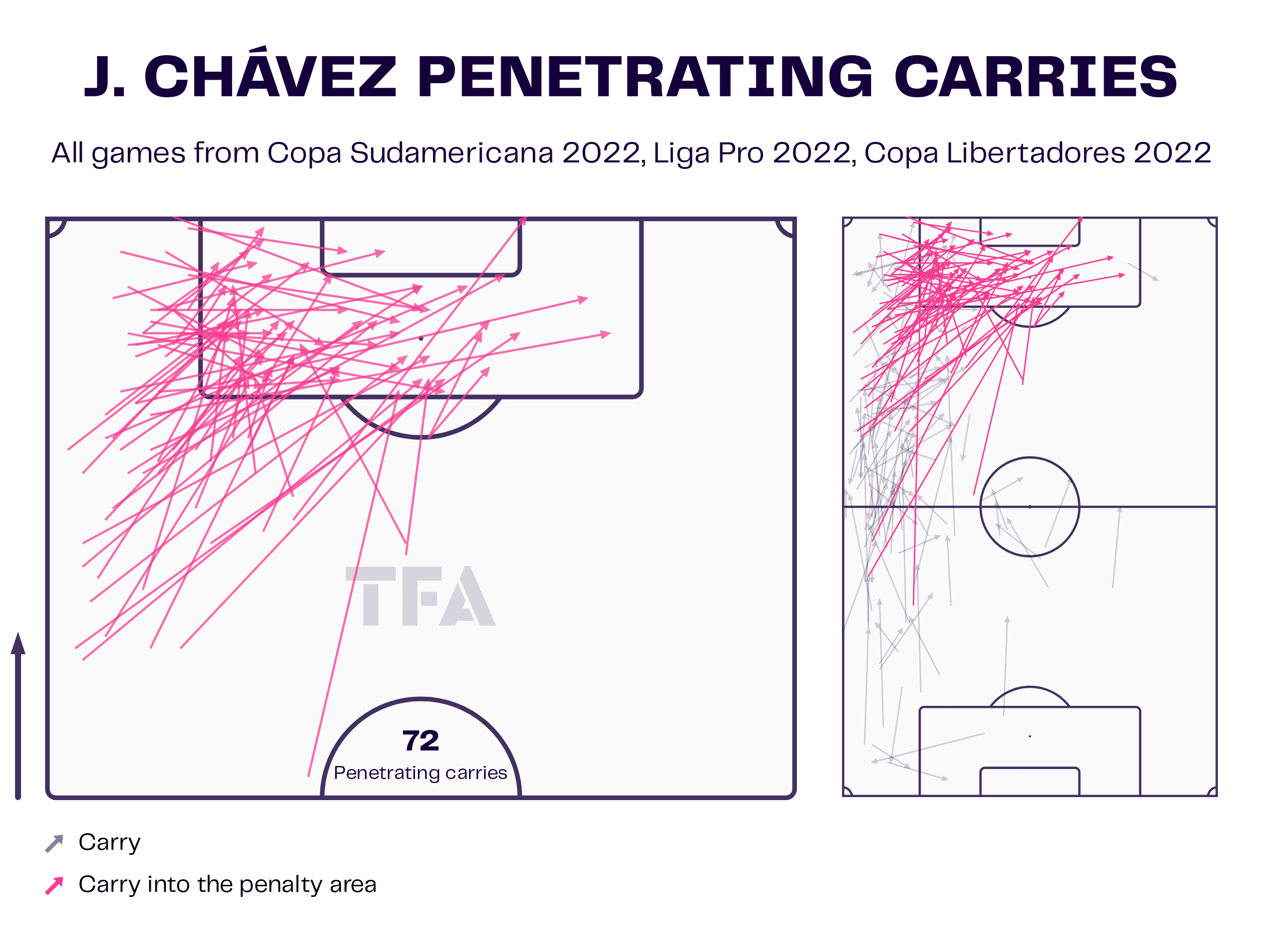
Jhoanner also adds an incredible resource in the attacking phase, as he has prove himself as an excellent goalscorer.
Normally, his goals are scored in a similar way as he makes the run behind the full-back, grabs a through-pass from a player at the edge of the box and takes a very powerful shot that often changes the placement inside the net, but the bottom and upper corners are sought.
His xG map shows incredible stats for a young full-back that is actually playing in the top tier of his country and top competitions as the Libertadores and Sudamericana Cup.
The graphic samples a high percentage of shots taken on the left side of the box, as he frequently places himself here.
However, shots from outside are also tried.
Jhoanner Chávez xG Map
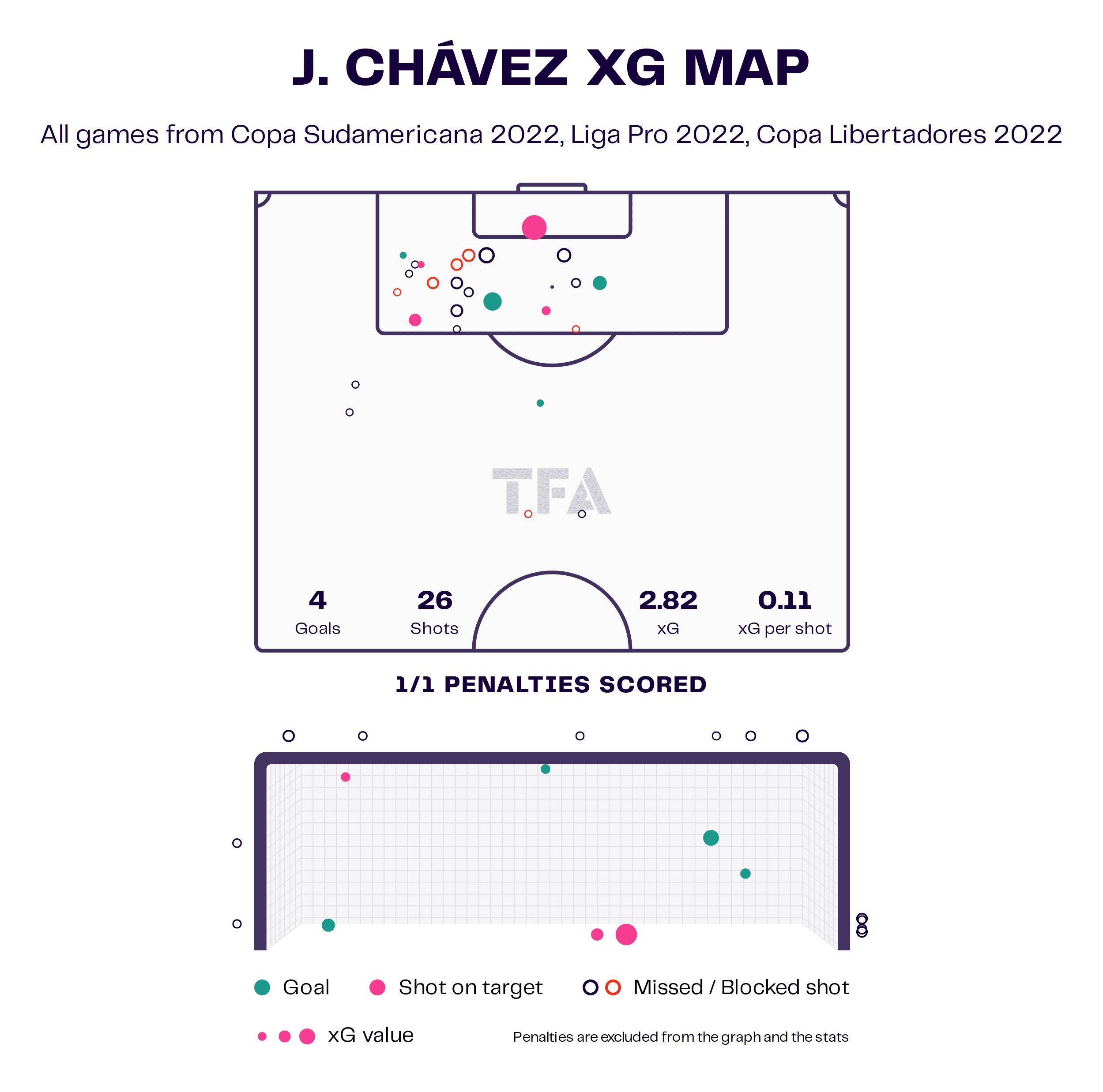
Another big asset inside Chávez’s game is the cut-back crosses and his deliveries from outside that are very dangerous for any defender in the box.
He likes to go very deep to take these passes, which are mostly found by Lautaro Díaz who has been excellent as a centre-forward for Independiente del Valle.
He knows that goals can be very simple in this way so he uses his incredible skills to get past players and then pass the ball back to one of the centre-forwards of the team, or a surprising midfielder that arrives from behind.
Jhoanner Chávez shows a very big output in the attacking phase, being basically one of the most key players in Anselmi’s system, thanks to the threat he produces from the left side of the pitch.
In attacking transitions, he’s a smart player to make runs with changes of rhythm and directions which are going to confuse defenders and he could be free to finish the transition.
Jhoanner Chávez Defensive phase
One of the aspects Chávez has to get better is the defence one.
As he’s an attacking-minded player, he forgets to get back and support his team to create a compact shape.
He can also be distracted to cover runs behind his back, so rivals tend to attack his zone with 2v1 situations.
Independiente is a high-pressing team that likes to defend in a high block and Chávez is an important element in this defensive style as he goes very high to mark tight rival full-backs to delete passing options at the wings.
One of the positives of playing with a back-three is that wing-backs can have the security to go forward as a player is constantly looking to protect him behind, but this is not going to happen always, as football, it’s just not like that, Mistakes are made and players have to solve situations.
In the following viz we can see the high-regains of Chávez, in which we see a tendency to defend very up and normally wide, marking rival full-backs.
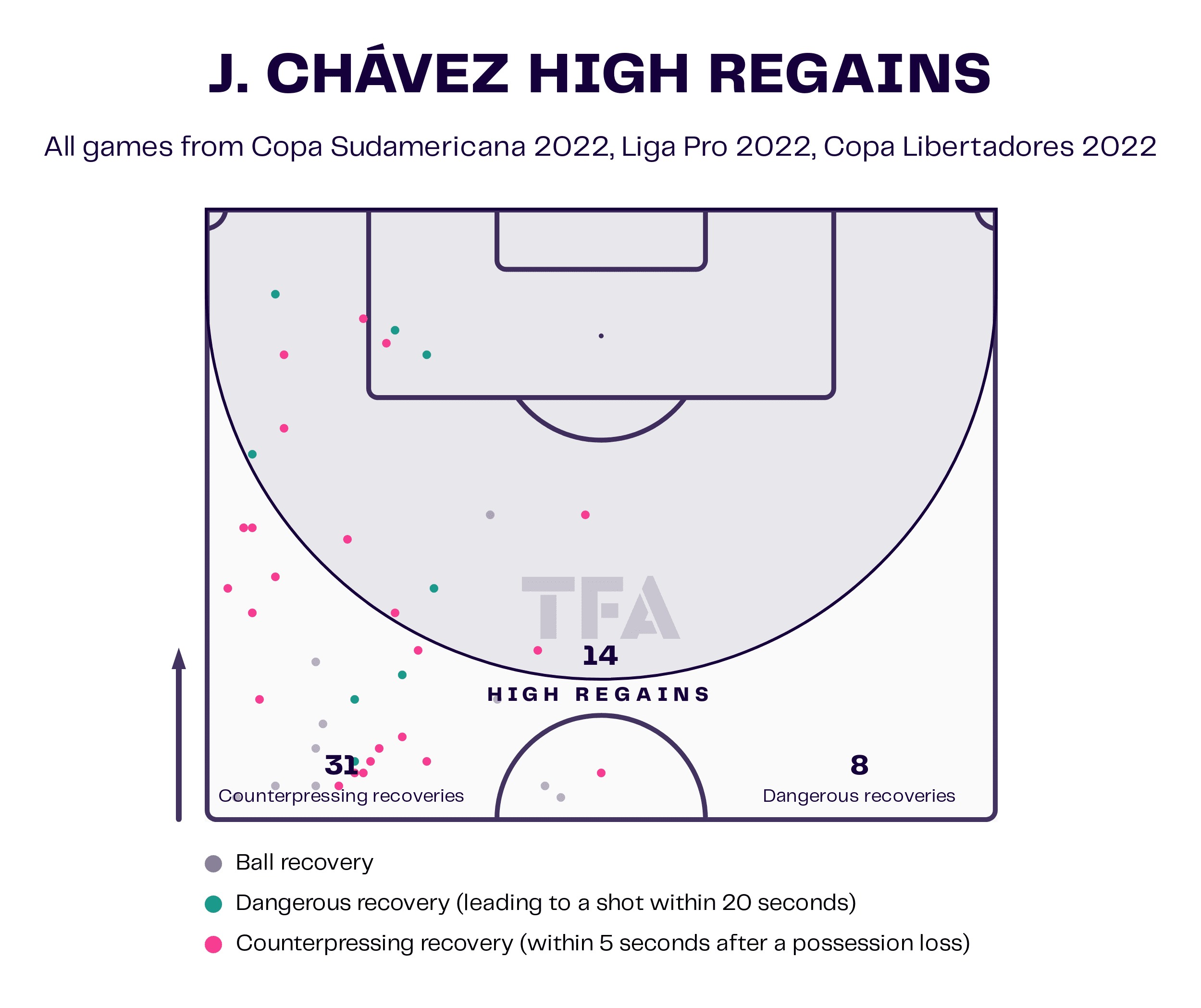
Jhoanner is not the best defender in terms of timing his tackles and measuring the power of his body slams to lay down players on the ball.
However, his intensity and proactivity allow him to intercept passes or block them as he tries to be everywhere with his mobility and speed.
This sometimes can be a negative thing in his game as he could be dragged off or go too high to defend a player and leave space at his back.
His defensive territory shows a lot of fouls that can describe his impetuous style of defending, adding more power than needed at times.
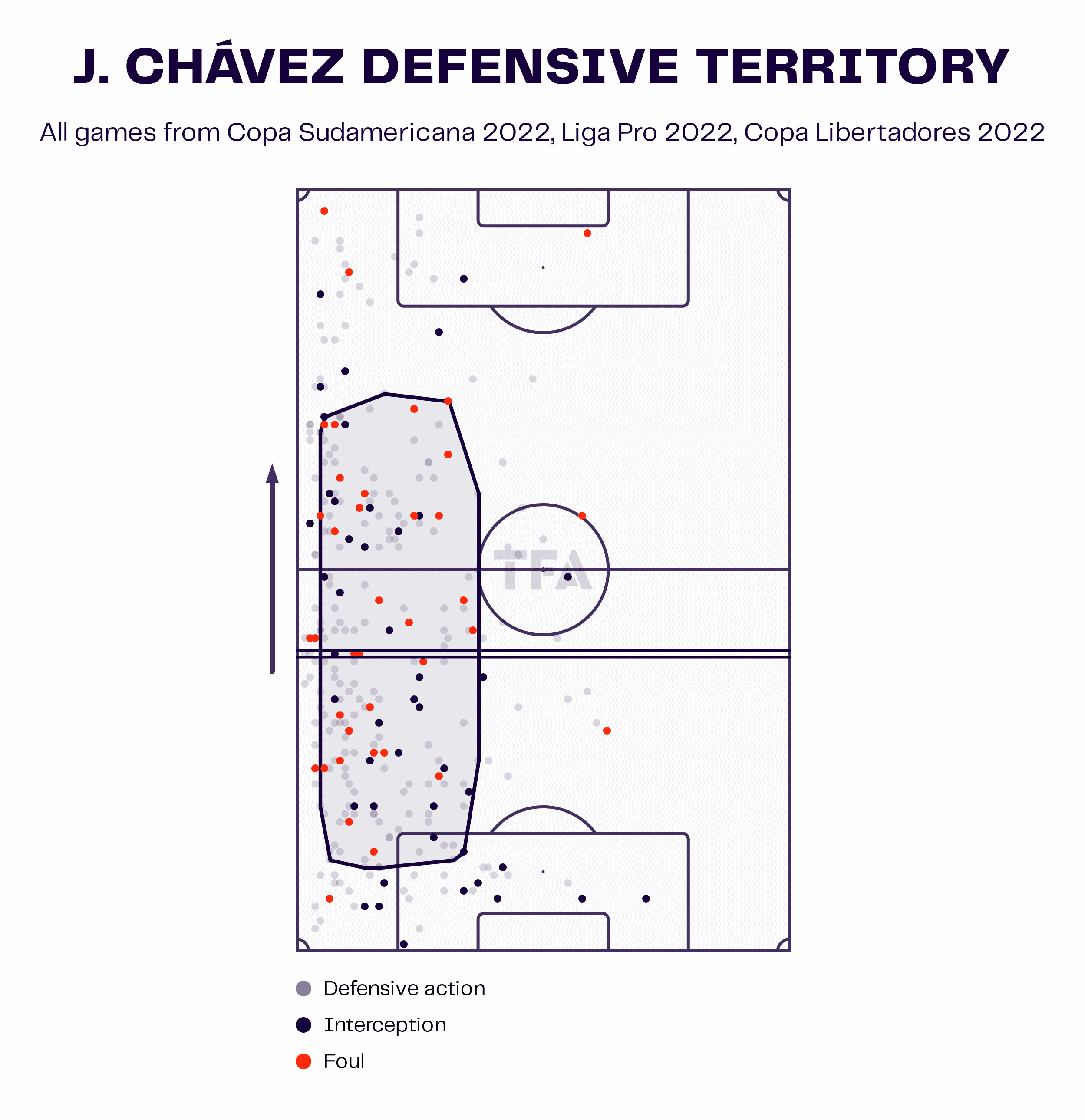
When the ball is being played at the other side of the pitch, he joins the box as another centre-back, and his 182cm are a helping hand as he also jumps high.
He’s attentive to defend low-crosses that try to find a player at the far post, he’s constantly scanning who’s at his back and he normally gives a good body shape to clear the ball out in dangerous moments that could end in an own-goal.
Against Sao Paulo, he showed excellent this defensive display inside the box to block options behind him and to join his own penalty area to support his team adding more elements and making it even more difficult for the Brazilian side to do something inside.
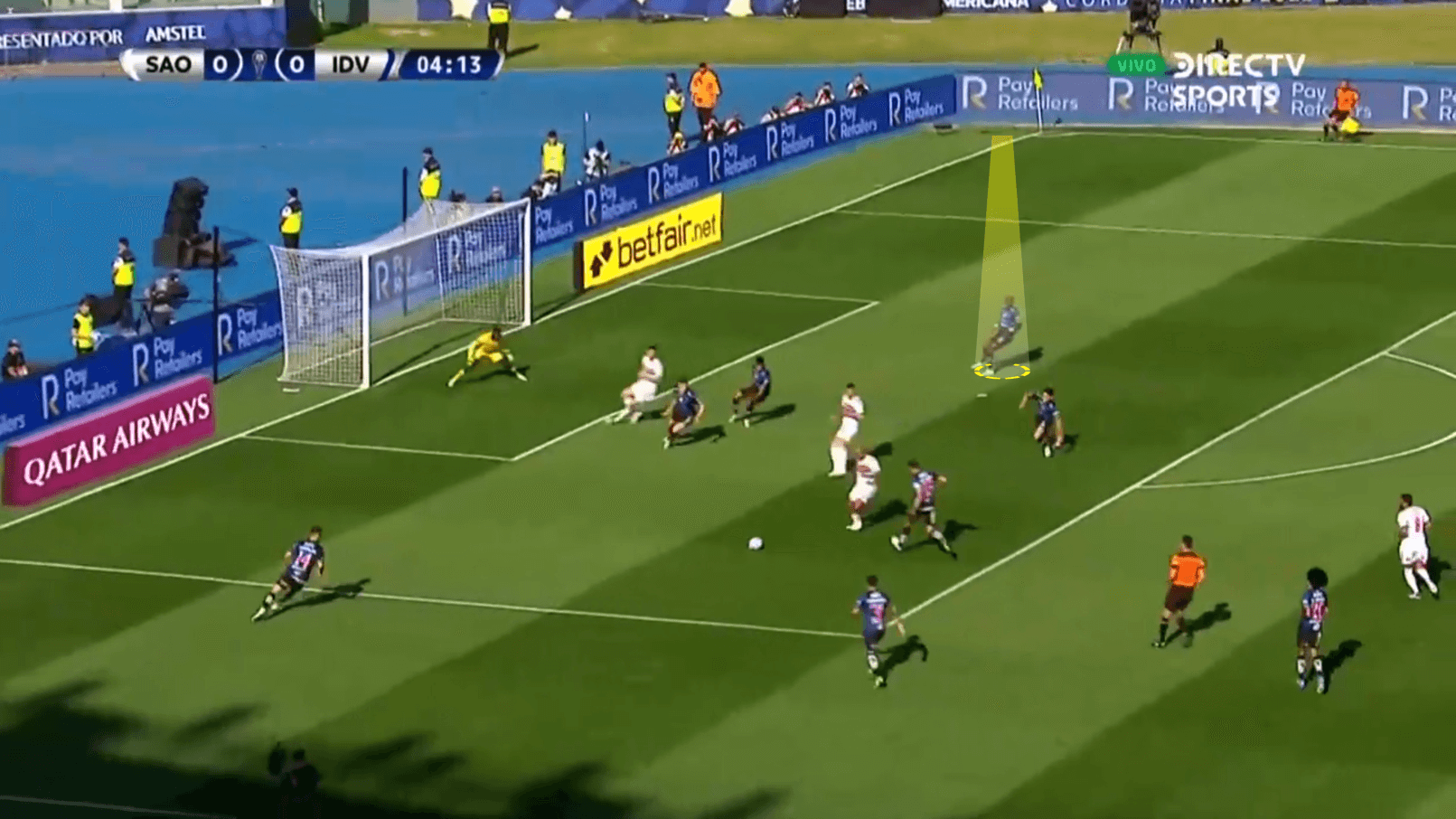
Conclusion
Jhoanner Chávez shows great talent, an intelligent tactical understanding to play in different zones, and technical qualities that lots of young players don’t have at his age.
Being developed as an attacking wing-back, he has the regular issues of covering his backs or his impulsive decisions to go off his line and make a foul.
The 20-year-old is a fantastic project of a player at the left-back spot that surely is going to attract European football teams, looking to sign him on a long contract to keep growing his interesting playing style.






Comments